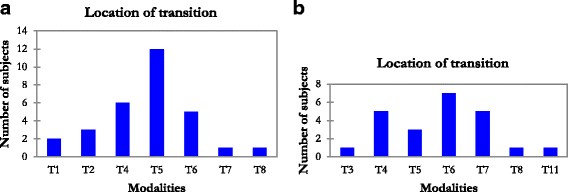Three-dimensional reconstructions of Lenke 1A curves
- PMID: 29435500
- PMCID: PMC5796345
- DOI: 10.1186/s13013-017-0149-4
Three-dimensional reconstructions of Lenke 1A curves
Abstract
Background: Scoliosis is a 3D deformity that can be reconstructed through 2D antero-posterior and lateral radiographs, which provide an upper view of the deformed spine as well as regional planes matching all vertebrae of elective plane for each curve. The objective of this study is to explore whether all idiopathic scoliosis classified Lenke 1A have the same 3D representation made with regional planes.
Methods: All patients treated for idiopathic thoracic scoliosis during the growth period and classified Lenke 1A were included in this study conducted in the pediatric spinal orthopedic department of Centre des Massues. A photogrammetric technique was used to obtain a 3D reconstruction, from regional planes identified on radiographs made with the EOS system. Three regional planes are usually identified in asymptomatic spines: lumbar, dorsal, and cervical-none of them presenting rotation. In the studied group, the number of planes, the rotation, and the limit vertebrae of each plane were looked for.
Results: Sixty-three patients were included (47 girls and 16 boys, mean age 11.3 years). The Cobb angle was meanly 36.5°. The scoliosis was reconstructed with three regional planes (57%) or four ones (43%, with the thoracic plane divided into two planes). Maximal rotation was found in the thoracic plane, especially when scoliosis was represented with four regional planes. The transition between planes 2 and 3 was mainly located between the fourth and sixth dorsal vertebrae.
Conclusion: The use of an arbitrary regional plane representation of a 3D shape leads to conclude that there are two types of Lenke 1A scoliosis, which should be taken into account for designing the brace.
Keywords: 3D reconstruction; Idiopathic scoliosis; Lenke classification; Regional planes; Thoracic; Upper view.
Conflict of interest statement
Jean-Claude Bernard is a physician doctor (in physical and rehabilitation medicine) and a senior clinician at the Centre Médico-Chirurgical de Réadaptation des Massues – Croix Rouge française, in Lyon, France. He received his PhD degree in 1986 and was appointed head of the pediatric department of Physical Medicine and Rehabilitation in Centre des Massues in 1994. He has an extensive experience in working with children with disabilities and has specifically a high daily clinical activity and great interest in spinal deformities in children. This interest has led to research to describe and measure the effects of conservative treatment in children and adolescents with back pain or deformities. Jean-Claude has published a number of journal articles and book chapters relating to his research. He is certified by the European Board of Physical and Rehabilitation Medicine until June 2019 and is also actively involved in medical learned societies, as SOFMER (Société Française de Médecine de Rééducation et Réadaptation Fonctionnelles), GES (Groupe d’Etude sur la Scoliose), SFCR (Société Française de Chirurgie du Rachis), EUROSPINE (Associated member), or SOSORT (Society on Scoliosis Orthopaedic and Rehabilitation Treatment). Eric Berthonnaud is a biomechanical engineer who has developed a great experience in assessing spinal and pelvic complex. He is working closely with clinicians, medical doctors, and surgeons on these issues at the Centre des Massues, and has published a lot of international papers regarding deformities and spinal balance. Julie Deceuninck is a physiotherapist and has been working for several years in the pediatric department at the Centre des Massues. She is also actively engaged in research about scoliosis and other spinal issues in children. Lydie Journoud-Rozand and Gregory Notin are orthoprosthesists at Etablissements Lecante, in Lyon, France. Both are particularly involved in orthopedic treatment for scoliosis and work actively with the medical team to develop new options for braces. Emmanuelle Chaleat-Valayer is a doctor in physical and rehabilitation medicine and a senior clinician at the Centre Médico-Chirurgical de Réadaptation des Massues – Croix Rouge française, in Lyon, France. Her extensive experience in spinal disabilities focuses on pain issues, especially in adults with or without deformities. She takes part in a number of research projects about the spine and has published a number of journal articles and book chapters relating to this research. She is also actively involved in medical learned societies, as SOFMER or ANMSR (Association Nationale des Médecins Spécialistes de Rééducation).This study was given the approval of the Croix-Rouge française ethic committee.Not applicable.The authors declare that they have no competing interests.Springer Nature remains neutral with regard to jurisdictional claims in published maps and institutional affiliations.
Figures




References
-
- Dubousset J. Three-dimensional analysis of the scoliotic deformity (chapter 22) In: Weinstein SL, editor. The pediatric spine: principles and practice. New York: Raven Press; 1994. pp. 479–496.
-
- Dubousset J. Scoliose idiopathique: définition, pathologie, classification, étiologie. Bull Acad Natl Med. 1999;183:699–704. - PubMed
-
- Goldstein L, Waugh T. Classification and terminology of scoliosis. Clin Orthop. 1973;93:10–22. - PubMed
LinkOut - more resources
Full Text Sources
Other Literature Sources
